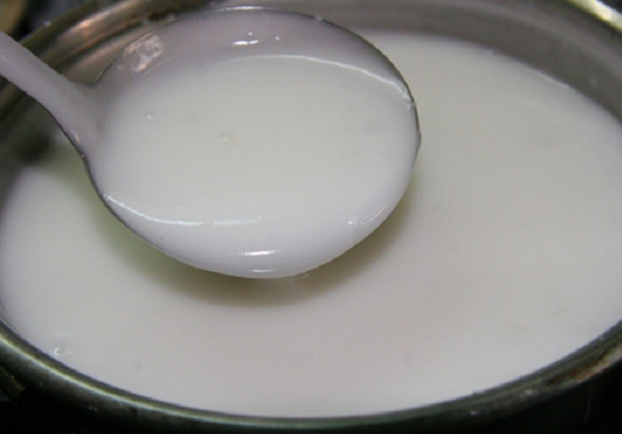How to Mix Rice Flour for Banh Cuon

To make tasty banh cuon we first need to know how to mix the rice flour properly. Start with plain rice flour which is the main ingredient. Pour the rice flour into a big bowl. You can find this flour at any grocery store. The rice flour should be soft and smooth without any lumps. If you see any lumps you can use your fingers to break them up.
Next slowly add water to the rice flour while stirring. Keep mixing until the flour and water form a smooth batter. This mixture will be used to make the thin delicate layers of banh cuon. Mixing the rice flour well is very important for making perfect banh cuon. Remember the better you mix the rice flour the tastier your banh cuon will be.
Adding Tapioca Starch to the Dough
Adding tapioca starch to the dough helps make the banh cuon soft and stretchy. Tapioca starch is a white powder that looks like flour. It comes from the cassava plant. To add tapioca starch, measure out the right amount and mix it into the rice flour batter you made earlier. This will help the dough become more flexible and easier to roll.
When you mix the tapioca starch into the rice flour batter make sure to stir it well. This will help the starch mix evenly with the rice flour. If you don’t mix it well some parts of your banh cuon might be too hard or too soft. So take your time and mix it thoroughly. This will make your banh cuon smooth and delicious.
The Right Amount of Water for Banh Cuon Dough
Using the right amount of water is very important when making banh cuon dough. If you add too much water the dough will be too runny and won’t hold together. If you add too little water the dough will be too thick and hard to spread. So it’s important to measure the water carefully. Usually you need about 600 ml of water for every 250 grams of rice flour.
Pour the water slowly into the rice flour and tapioca starch mixture. Stir continuously as you add the water to make sure it mixes evenly. The goal is to get a smooth liquid batter that is not too thick or too thin. This perfect balance will help you make the best banh cuon. Remember the right amount of water makes the dough just right.
Mixing the Dough Smoothly
Mixing the dough smoothly is a key step in making banh cuon. After adding the water and tapioca starch use a whisk or a spoon to stir the mixture well. You should mix it until there are no lumps left. A smooth batter will make your banh cuon layers thin and even.
If you see any lumps keep stirring until they disappear. You can also use a blender to mix the dough which will help make it very smooth. The smoother the dough the better your banh cuon will look and taste. So take your time and make sure the dough is mixed well. Smooth dough makes perfect banh cuon.
Adding Salt and Oil to the Dough
Adding a little salt and oil to the dough can make your banh cuon even tastier. Salt adds flavor to the dough while oil helps make the dough smooth and shiny. Add half a teaspoon of salt and one teaspoon of oil to the rice flour mixture. Stir well to make sure they mix evenly with the dough.
The salt and oil will make the dough taste better and easier to handle. When you cook the banh cuon the oil helps prevent it from sticking to the pan or cloth. This makes it easier to roll the banh cuon without tearing. So don’t forget to add salt and oil to your banh cuon dough for the best results.
Resting the Banh Cuon Dough
After mixing all the ingredients it’s important to let the dough rest. Letting the dough rest for about 30 minutes helps the ingredients blend together. This makes the dough more elastic and easier to work with. Just cover the bowl with a cloth or plastic wrap and let it sit on the counter.
Resting the dough also helps it develop a better texture. When you cook the banh cuon it will be softer and more tender. So be patient and give the dough some time to rest. This simple step can make a big difference in the quality of your banh cuon.
Tips for Perfect Banh Cuon Dough
Here are some tips to help you make the perfect banh cuon dough. First, always use fresh ingredients. Fresh rice flour and tapioca starch will give you the best results. Second, mix the dough thoroughly to avoid any lumps. Smooth dough makes smooth banh cuon.
Another tip is to use a non-stick pan or cloth when cooking the banh cuon. This will prevent the dough from sticking and tearing. Lastly, practice makes perfect. The more you make banh cuon the better you will get at it. So don’t be afraid to try a few times until you get it just right.
Common Mistakes in Cách Pha Bột Bánh Cuốn
One common mistake in cách pha bột bánh cuốn is not mixing the dough well enough. If the dough is lumpy the banh cuon will be uneven and might tear. Another mistake is using too much or too little water. This can make the dough too thick or too runny making it hard to cook properly.
Another common mistake is not letting the dough rest. If you skip this step the banh cuon might be tough and chewy. Lastly, not adding enough salt or oil can make the dough bland and sticky. So avoid these mistakes to make the best banh cuon.
Enjoy Your Homemade Banh Cuon
Now that you know how to make the perfect banh cuon dough it’s time to enjoy your homemade banh cuon. Cook the dough on a non-stick pan or cloth, add your favorite fillings and roll them up. You can fill your banh cuon with minced meat, mushrooms or even vegetables.
Serve your delicious banh cuon with some dipping sauce and fresh herbs. Your family and friends will love this tasty dish. Making banh cuon at home can be fun and rewarding. So enjoy your homemade banh cuon and share it with your loved ones.
Conclusion
Making banh cuon dough at home is easy if you follow the right steps. Start by mixing the rice flour then add tapioca starch, water salt and oil. Mix the dough smoothly and let it rest before cooking. Avoid common mistakes like not mixing well or using the wrong amount of water. With these tips you can make perfect banh cuon dough every time. Enjoy the process and have fun making this delicious dish at home.




